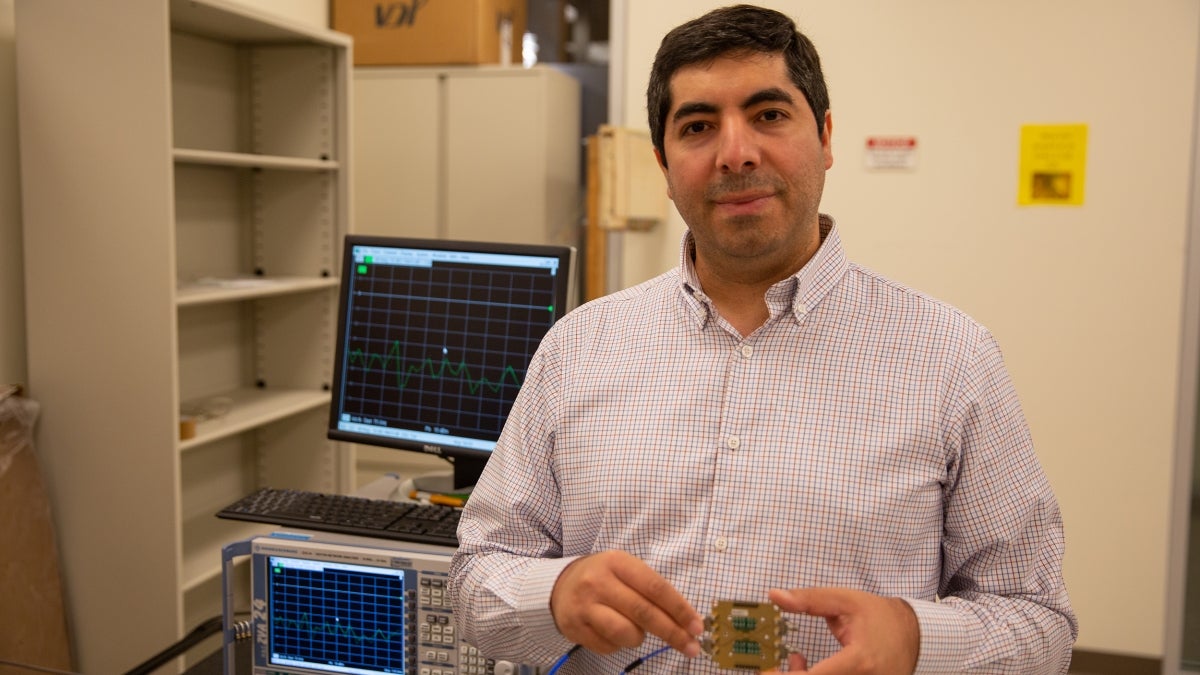Timing is everything

Saeed Zeinolabedinzadeh, an assistant professor of electrical, computer and energy engineering in the Ira A. Fulton Schools of Engineering at Arizona State University, is developing a new, high-precision, low-latency and cost-effective time transfer scheme for wireless communication in a project funded by a DARPA Young Faculty Award. Photo by Connor McKee/ASU
If your smartphone could only connect to a single tower, it wouldn’t be a very reliable communication system. The same is true for many other types of communication, sensing and navigation systems such as 5G networks, wireless sensor networks and vehicle-to-vehicle communication systems.
Distributed systems outperform the traditional centralized systems in terms of cost, communication reliability, data rate, system flexibility, imaging precision, real-time awareness and tolerance to interference.
In addition, by improving their relative positioning and timing measurements, these systems can enable new applications in 5G and 6G communications, sensing, navigation, imaging and distributed computing, said Saeed Zeinolabedinzadeh, an assistant professor of electrical computer and energy engineering in the Ira A. Fulton Schools of Engineering at Arizona State University.
However, distributed systems require a precise common clock. Exact and low-latency wireless time transfer is one of the most challenging aspects of distributed systems that limits their capacity for use in more complex and higher-frequency applications.
Zeinolabedinzadeh is working on a new, high-precision, low-latency and cost-effective time transfer scheme for wireless communications, including 5G, 6G, wireless sensor networks, navigation and defense applications.
“Our proposed approach significantly increases the synchronization accuracy and reduces the synchronization time,” Zeinolabedinzadeh said. “In addition, the system can robustly operate while the radios within a communication system are moving at high speed such as a user in the 5G network.”
Such improvements would enhance the performance and reliability of wireless systems used for national security as well as other communications applications.
The project, “Novel Analog Wireless Synchronizing Scheme for Extremely Low Latency Time Transfer,” has caught the attention of the Defense Advanced Research Projects Agency, or DARPA, and earned Zeinolabedinzadeh a DARPA Young Faculty Award.
DARPA Young Faculty Awards provide recipients funding, mentoring and connections to develop their ideas and expand research that is beneficial to national security. Zeinolabedinzadeh’s project will be supported by $500,000 in funding over two years with a chance for an additional $500,000 the following year.
“Saeed is working to improve critical aspects of synchronization across our connected world,” said Stephen Phillips, director of the School of Electrical, Computer and Energy Engineering, one of the six Fulton Schools. “His selection for a DARPA Young Faculty Award confirms the importance and potential impact of his research to applications of interest to the United States defense infrastructure and much more.”
Zeinolabedinzadeh’s work addresses shortcomings that have been acknowledged in other communication structures. GPS systems have been used for time transfer, but these systems cannot satisfy the timing accuracy required for today’s high-frequency applications with extremely high data rates.
“One of the main challenges of the realization of high-frequency distributed systems is precise timing synchronization with minimal latency,” Zeinolabedinzadeh said. “Depending on the frequency and data rate, a subnanosecond synchronization accuracy is required for practical systems. Precise estimation of the relative location and high-accuracy time transfer with minimal latency are some of the challenges that we are addressing in this project. One of the great advantages of the proposed methods is the reliable operation in GPS-denied regions.”
Zeinolabedinzadeh’s goal is to demonstrate the proposed new concepts with a practical implementation using “advanced integrated circuit technology that is found in almost any portable, low-cost wireless system used today.”
The outcomes Zeinolabedinzadeh envisions for his research could impact many emerging connected technologies from the internet of things to next-generation 5G systems to smart autonomous vehicles and a wide range of other wireless communication and imaging systems.
“The safety and security of our lives today is directly tied to these technologies,” Zeinolabedinzadeh said. “Therefore, any step in the technological advancement of these systems will improve human safety, security, social life and the economy.”
Being selected for a DARPA Young Faculty Award presents unique opportunities for Zeinolabedinzadeh and his research team in the Millimeter-Wave, Terahertz and Photonic Integrated Circuits Lab.
“It is going to shape our research in an interesting direction that can have a major impact in the future of wireless systems,” Zeinolabedinzadeh said.
More Science and technology

ASU researcher part of team discovering ways to fight drug-resistant bacteria
A new study published in the Science Advances journal featuring Arizona State University researchers has found…

ASU student researchers get early, hands-on experience in engineering research
Using computer science to aid endangered species reintroduction, enhance software engineering education and improve semiconductor…

ASU professor honored with prestigious award for being a cybersecurity trailblazer
At first, he thought it was a drill.On Sept. 11, 2001, Gail-Joon Ahn sat in a conference room in Fort Meade, Maryland.…